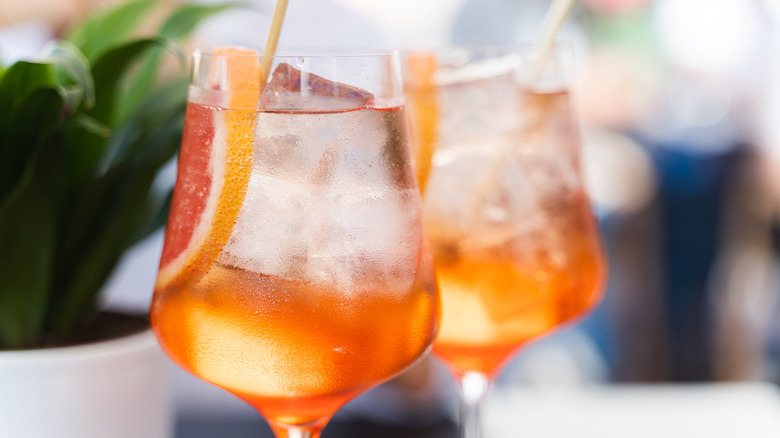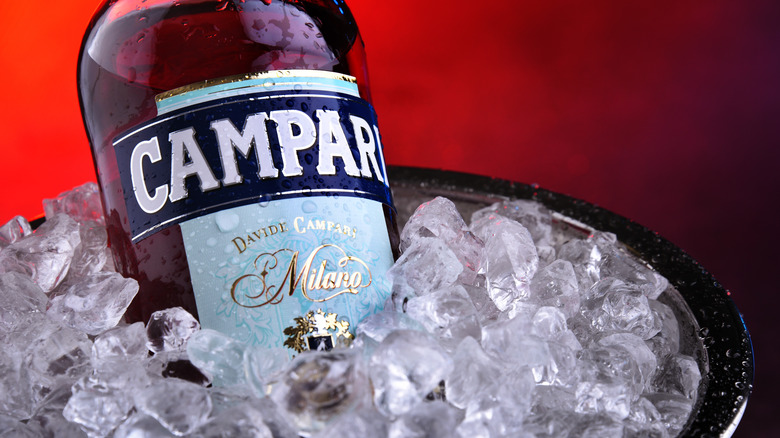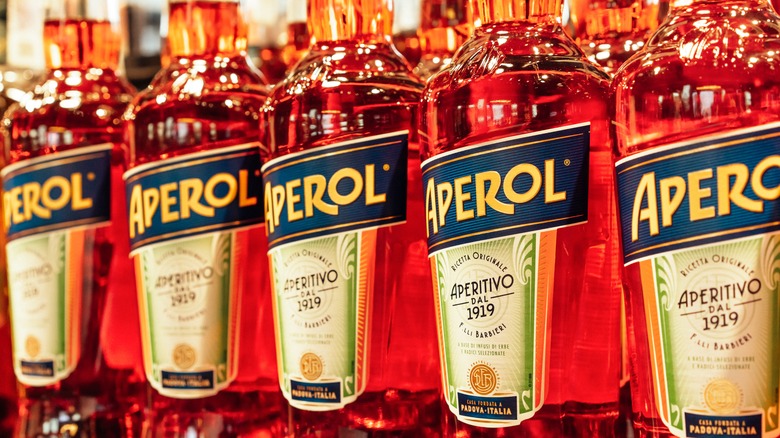The Sweet Quality That Sets Aperol And Campari Apart
Aperol and Campari are often grouped together on liquor store shelves, and that's not an accident. Both are of Italian origin, and both belong to a class of drinks known in Italy as red bitter liqueurs. This category is generally distinguished by low alcohol levels — less than 28% alcohol by volume (ABV), on average — consistent with their use as aperitivos, or before-dinner drinks.
Traditionally, the recipes for Aperol and Campari, as well as other competing red bitter liqueurs, including Aperitivo Select and Luxardo Bitter Liqueur, are kept secret. But all feature a mix of herbs, fruit, and spices to go with their alcohol bases. If those similarities aren't enough, Aperol and Campari just happen to be owned by the same beverage company: Grupo Campari.
Of course, there are also some rather obvious differences. Color is one; Aperol has a more orangish cast than Campari's carmine tint. Taste is another. Although both are classed as red bitter liqueurs, Campari is more bitter, and less sweet, than Aperol. The two liqueurs have also become famous for their use in distinctly different cocktails, although this is attributable not just to their differing flavor profiles and wildly divergent ABVs, but also to their very different histories.
Campari's rich history
Campari is Italy's original red bitter liqueur. While the histories of most of its competitors date back to the late 19th century or later — Aperol, for example, was first released in 1919 — Campari's is significantly older. The liqueur's namesake, Gaspare Campari, had apparently been searching for the perfect recipe for twenty years before his efforts ultimately paid off in 1860. That's the year he started serving the drink in his caffè in Novara, not far from Milan. Tellingly, virtually all of the red bitter liqueurs which would follow were also created in Northern Italy.
It's believed that Campari's finished product contained as many as 80 ingredients, although the only ones the company has ever admitted to were alcohol and water. None, however, have ever been changed from the original recipe. Cascarilla, a tree bark, and Chinotto, a bitter orange-flavored soda, are both thought to be ingredients in the iconic drink. And the 24% ABV liqueur's trademark carmine hue was, at least until 2006, the result of a cochineal insect dye.
By the 1920s, Campari had become associated with two classic cocktails: the Americano and Negroni. The former, which pairs Campari with sweet vermouth and soda water, was developed in Italy, but it takes its name from the popularity of the drink with Americans. The latter, meanwhile, supposedly gets its name from Count Camillo Negroni, an Italian aristocrat who supposedly preferred Americano cocktails with gin instead of soda water. However, this story is probably apocryphal.
Aperol and its most famous cocktail
Invented in 1919 by the Barbieri brothers, Silvio and Luigi, who debuted their aperitivo at that year's Padua International Fair, Aperol is notable for being sweeter than Campari. But it's also decidedly lighter, thanks to its mere 11% ABV. Padua, of course, is also in Northern Italy — aperitivo country — but it's closer to Venice than Milan, where Campari established its first production facility. Like its fellow Grupo Campari product, Aperol keeps its recipe a secret. A few ingredients have slipped out over the years, however, including rhubarb, along with bitter and sweet oranges. Cinchona, another tree bark, and gentian root are also thought to be included.
Aperol is indelibly associated with one cocktail: the Aperol Spritz, which pairs Aperol with sparkling Italian Prosecco and soda water. Although the drink has been a favorite in Italy since at least the 1950s, its global popularity has boomed in recent years. In fact, during a 15-year period beginning in 2004, sales for the liqueur increased by a staggering 16.5% per year, a growth that even outpaced Grupo Campari's namesake product.
Aperol's lightness has likely contributed to its recent popularity, as it has dovetailed with a trend toward lighter cocktails. Its sales aren't slowing down, either. Aperol continued its torrid growth with a 23% uptick during 2023's first quarter, according to VinePair. It is now not only outgrowing Campari, but outselling it, too.



